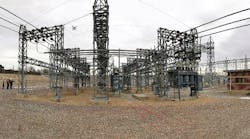In 2017, Xcel Energy Inc. started implementing its advanced grid intelligence and security initiative in the Colorado, U.S., jurisdiction. A key part of the advanced grid initiative includes building out an advanced distribution management system (ADMS), which automates grid operations, improves the speed and efficiency of response to variations in customer power usage, and facilitates analyses of and planning for customers’ future energy use. ADMS also improves monitoring and control, enabling the utility to respond more quickly to outages. In the Colorado advanced grid timeline, Xcel Energy expects to deploy ADMS in the first quarter of 2019.
Information gathered from substation equipment — including nameplate data from circuit switchers, transformers, switches and breakers — will be loaded into ADMS to optimize Xcel Energy’s distribution grid. This information helps the back office to understand and plan for the capacities and limitations of each piece of substation equipment. However, because of accessibility issues, gathering some of this information can be time consuming and expensive. To overcome these challenges, Xcel Energy has brought unmanned aircraft systems (UAS) to the rescue.
Nameplates
Of all the substation equipment elements, nameplates are the most crucial for ADMS, because they provide data that enables the distribution system to adjust automatically based on load. The nameplate, which includes manufacturer information, shows ratings for each component in the substation. From this, Xcel Energy better understands the substation equipment tolerances, so the grid can be run optimally. Most equipment nameplates can be read from the ground, but some nameplates are not visible from below because of installation locations and angles. Historically, reading these nameplates has required dispatching a field crew, switching the substation off-line, viewing the nameplates from a bucket truck, writing the information down, extracting the crew and switching the substation back on-line.
Recent developments in UAS technology have helped Xcel Energy to gather nameplate information from above safely, efficiently and securely without the need for switching a substation off-line. The utility now documents nameplates with high-resolution UAS cameras. What used to be an expensive, time-consuming task now can be accomplished in a matter of a few minutes. Over time, some nameplates have become so weathered the information they once contained is now lost to history. With UAS, there is no need to switch a substation off-line only to find the information on the nameplate cannot be read anyway.
Xcel Energy now flies unmanned aircraft inside energized substations without risking human safety. These flights comprehensively identify nameplate presence, locations, conditions and ratings. If nameplates have disappeared or cannot be read, UAS imagery documents this condition so there is no confusion later. For example, "Did we try to read that? I can’t remember" becomes "Did we try to read that? We did, here’s a photo of the broken rivets where the nameplate used to be."
Special Situations
Xcel Energy also has used UAS missions to populate ADMS data fields in transmission substations and walled substations where bucket truck access is minimal or impossible in anything other than emergency situations. The utility uses crews on the ground to read and document nameplates whenever possible, then switches to unmanned aircraft to read the remaining nameplates that may be hard to decipher or out of reach.
Xcel Energy’s electric distribution and natural gas transmission groups also have benefitted from UAS technology through documenting pre-construction, mid-construction and post-construction conditions of natural habitats, urban neighborhoods and industrial areas around projects — facilitating accurate and efficient communication with regulatory agencies and property owners.
Of course, there have been many learning opportunities and challenges along the way. Xcel Energy has had to experiment with various systems, sensors and settings to build the UAS solution that produces the best results for reading substation nameplates. Some unmanned aircraft models cannot carry the high-resolution imaging equipment necessary to capture finely stamped or partially eroded nameplate data. Some sensors provide great imagery to controllers during flight but record such low-quality images in their saved files that nameplates, which looked great in the field, cannot be read in downloaded data. Learning to work with natural lighting conditions in unusual angles and within the complex set of shadows, created by overlapping layers of substation equipment, also took some trial and error.
Additionally, UAS settings must be aligned carefully to ensure safety if the aircraft and controller lose communication during flight. They also must be calibrated to ensure the highest-quality images are collected — not just on the screen at the time but recorded for review after the flight. Weather can be the biggest challenge, with unmanned aircraft missions canceled because of rain, snow, high winds, low temperatures or any combination thereof.
3-D Models
In addition to close-in flying for nameplate documentation, UAS also are capturing hundreds of overlapping images of the substation from above, creating high-resolution ortho-mosaics and 3-D models of the entire substation. These ortho-mosaics and 3-D models are accurate to within fractions of an inch (several millimeters) from one end of a substation to the other. By having these 3-D ortho-mosaics, engineering and operational personnel can manage and track assets at a given location in the substation — and the data can be leveraged in many applications across the enterprise.
Importantly, errors in existing documentation — such as a piece of equipment present in the substation but not present in line drawings or vice versa — can be identified, communicated and corrected. If a modification or any construction is being considered, 3-D models with highly accurate contour lines can be used to support these activities.
Learning from Challenges
Xcel Energy has learned a great deal from these challenges. Besides the importance of using a very high-resolution camera on the UAS, the utility has confirmed unmanned aircraft are most likely to capture successful results in the high-energy environment of a substation when the operator is a well-trained, practiced pilot who is an expert in executing these types of missions. Specifically, flying within the magnetic fields of transmission voltages as well as within airspace cluttered by vertical obstructions — such as lightning rods, like open switchblades — and horizontal obstructions — like transmission, distribution and overhead shield wires — requires active piloting.
Throw in shifting winds, intermittent losses of GPS locks and varying lighting conditions, not only is a pilot with a steady hand needed but also one who understands the intricacies of digital photography in general and how the UAS camera operates in particular. For these reasons, UAS technology is not a magic bullet. In cold climates or areas subject to consistently high winds, UAS technology may not yet support the mission, particularly if information is needed right now and conditions do not permit a safe UAS flight.
New Possibilities
UAS also certainly does not replace substation personnel who have their own critical roles in day-to-day operations and supporting ADMS. Substation personnel also have been standing side by side with UAS operators on all substation missions to ensure the pilots remain outside of airspace that might be bridged by electric current, provide a second perspective when the aircraft is moving in 3-D space among obstacles and be ready to respond immediately in case an unplanned event should occur.
Ultimately, Xcel Energy has learned using UAS technology to gather substation information is cost effective and efficient. This cutting-edge use of technology has contributed greatly to integrating ADMS into the utility’s advanced grid initiative far more widely than would have been possible otherwise.
Acknowledgment
This article is dedicated to the memory of Jonathan Trujillo, a substation journeyman who guided UAS pilots through many of the substations mentioned in this article but who passed away prior to completion of the project. ♦
J. Peter Gomez is Xcel Energy’s data program manager for the company’s Advanced Grid Intelligence and Security. With more than 32 years with the company, Gomez is recognized internationally as a subject matter expert in data system implementation and the development of automated applications. His expertise in the areas of gas and electric distribution system operations, as well as IT system design and application development, have made him a sought-after resource in the global IT community.
Eileen P. Lockhart has been program manager for Xcel Energy Inc.’s UAS program since its inception in 2015. Under her leadership, Xcel Energy became one of the first U.S. utilities to obtain Federal Aviation Administration approval to fly UAS missions. Lockhart also represents Xcel Energy on the Edison Electric Institute’s UAS team, IEEE UAS team and Electric Power Research Institute’s UAS-tailored collaboration project.
James F. Dwyer is a certified UAS pilot, certified wildlife biologist and environmental scientist at EDM International Inc. He works with electric utilities in North America and Europe to develop decision-relevant UAS operations, science and wildlife research; answer specific electric utility-related questions; and facilitate environmentally responsible industrial and utility operations.
Andrew H. Stewart is a principal of EDM International Inc. as well as EDM’s president. For more than 30 years, he has devoted his work to helping utilities meet power-delivery asset management challenges; promoting research and development; and applying new technologies, such as UAS, to enhance the safety, reliability and life of electric utility assets.







